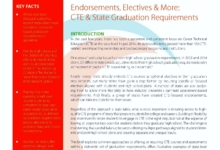In 2014, the New York State Board of Regents approved rule changes that allowed for multiple pathways to graduation, including a CTE pathway. Before 2014, students had to pass five high school Regents exams, in the subjects of English, science, mathematics, U.S. history and global studies. Under the new requirements, students still have to pass the English, science and mathematics exams, but will have the option of replacing one of the two social studies exams with a humanities, STEM, biliteracy, CTE or arts exam.
For the CTE pathway, students must successfully complete a state-approved CTE program, and then they may take one of the 30 state-approved assessments, aligned with the CTE program’s field of study. The assessments were chosen by a Technical Assessment Review Panel, based on the following four criteria:
- The assessment provides credible evidence that the student is college and career ready. An assessment would meet this criterion if it is widely accepted by an industry sector and/or postsecondary institutions;
- The assessment includes academic as well as technical learning;
- The assessment is for an occupation in a career cluster that is recognized by the State Education Department and is of clear economic value to the state of New York; and
- The assessment meets the following technical requirements:
- The exam is aligned with existing knowledge and updated regularly (every four years in most cases); and
- The exam has acceptable psychometric properties; and
- The organization responsible for the exam is considered credible by the State Education Department.
The number of approved assessments has stayed relatively low because of the state’s rigorous selection process. The state has also set cut scores for each assessment to ensure rigor across the board. Under this system, a student receiving a diploma under the CTE pathway is held to the same academic rigor as a student who chose the humanities pathway. In many ways the CTE pathway can be more rigorous, as students must also demonstrate mastery in a practical skill, not just in an academic setting.
Policy in Action
The new pathway options are now in effect, first applying to the graduating class of 2015. However, the state is not disaggregating graduation rates based on which pathways students pursue. It stands to reason that more students will take advantage of this flexible pathway option, taking into account statewide efforts such as the expansion of P-TECH like high schools and CTE-focused high schools in New York City.
Related Links
- Press release
- Text of regulation
- Resources on multiple pathways
- Overview of CTE assessment criteria
- Approved CTE assessments and cut scores






